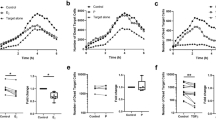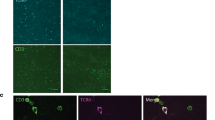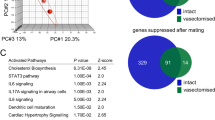Abstract
To reconcile immunity and reproduction, females must allow spermatozoa to survive and control the presence of commensal microbiota and sexually transmitted pathogens during ovulation. Female steroid sex hormones exert a powerful effect on the immune system, as do the hormonal changes associated with the ovarian cycle. Dendritic cells (DCs) are immunological sentinels that link innate immunity to adaptive immunity. Upon exposure to microbial invaders in tissue, they undergo a maturational process that culminates in the lymph nodes and activates T-cell-specific immune responses. Estradiol, which is highly expressed during ovulation, has an effect on the maturation of DCs, although the molecular mechanism remains elusive. We detected that estradiol regulates expression of Ikbkg in DCs and modulates nuclear factor-κb translocation to the nucleus, thus explaining the reduced DC function observed during ovulation. This change may be an adaptive mechanism to reconcile control of infection and reproductive functions.
This is a preview of subscription content, access via your institution
Access options
Subscribe to this journal
Receive 6 digital issues and online access to articles
$119.00 per year
only $19.83 per issue
Buy this article
- Purchase on Springer Link
- Instant access to full article PDF
Prices may be subject to local taxes which are calculated during checkout






Similar content being viewed by others
References
Brabin L, Brabin BJ . Parasitic infections in women and their consequences. Adv Parasitol 1992; 31: 1–81.
Daniels CW, Belosevic M . Serum antibody responses by male and female C57Bl/6 mice infected with Giardia muris. Clin Exp Immunol 1994; 97: 424–429.
Komukai Y, Amao H, Goto N, Kusajima Y, Sawada T, Saito M et al. Sex differences in susceptibility of ICR mice to oral infection with Corynebacterium kutscheri. Exp Anim 1999; 48: 37–42.
Giron-Gonzalez JA, Moral FJ, Elvira J, Garcia-Gil D, Guerrero F, Gavilan I et al. Consistent production of a higher TH1:TH2 cytokine ratio by stimulated T cells in men compared with women. Eur J Endocrinol 2000; 143: 31–36.
Beagley KW, Gockel CM . Regulation of innate and adaptive immunity by the female sex hormones oestradiol and progesterone. FEMS Immunol Med Microbiol 2003; 38: 13–22.
Whitacre CC, Reingold SC, O'Looney PA . A gender gap in autoimmunity. Science 1999; 283: 1277–1278.
Hughes GC, Clark EA . Regulation of dendritic cells by female sex steroids: relevance to immunity and autoimmunity. Autoimmunity 2007; 40: 470–481.
Ober C, Loisel DA, Gilad Y . Sex-specific genetic architecture of human disease. Nat Rev Genet 2008; 9: 911–922.
Wira CR, Fahey JV . A new strategy to understand how HIV infects women: identification of a window of vulnerability during the menstrual cycle. AIDS 2008; 22: 1909–1917.
Nilsson S, Gustafsson JA . Biological role of estrogen and estrogen receptors. Crit Rev Biochem Mol Biol 2002; 37: 1–28.
Dunbar B, Patel M, Fahey J, Wira C . Endocrine control of mucosal immunity in the female reproductive tract: impact of environmental disruptors. Mol Cell Endocrinol 2012; 354: 85–93.
De Bernardis F, Lucciarini R, Boccanera M, Amantini C, Arancia S, Morrone S et al. Phenotypic and functional characterization of vaginal dendritic cells in a rat model of Candida albicans vaginitis. Infect Immun 2006; 74: 4282–4294.
LeBlanc DM, Barousse MM, Fidel PL Jr . Role for dendritic cells in immunoregulation during experimental vaginal candidiasis. Infect Immun 2006; 74: 3213–3221.
Romani L, Montagnoli C, Bozza S, Perruccio K, Spreca A, Allavena P et al. The exploitation of distinct recognition receptors in dendritic cells determines the full range of host immune relationships with Candida albicans. Int Immunol 2004; 16: 149–161.
Cambi A, Netea MG, Mora-Montes HM, Gow NA, Hato SV, Lowman DW et al. Dendritic cell interaction with Candida albicans critically depends on N-linked mannan. J Biol Chem 2008; 283: 20590–20599.
Buelens C, Verhasselt V, De Groote D, Thielemans K, Goldman M, Willems F . Human dendritic cell responses to lipopolysaccharide and CD40 ligation are differentially regulated by interleukin-10. Eur J Immunol 1997; 27: 1848–1852.
Sallusto F, Schaerli P, Loetscher P, Schaniel C, Lenig D, Mackay CR et al. Rapid and coordinated switch in chemokine receptor expression during dendritic cell maturation. Eur J Immunol 1998; 28: 2760–2769.
Israel A . The IKK complex, a central regulator of NF-kappaB activation. Cold Spring Harb Perspect Biol 2010; 2: a000158.
Reis e Sousa C . Dendritic cells in a mature age. Nat Rev Immunol 2006; 6: 476–483.
Rescigno M, Citterio S, Thery C, Rittig M, Medaglini D, Pozzi G et al. Bacteria-induced neo-biosynthesis, stabilization, and surface expression of functional class I molecules in mouse dendritic cells. Proc Natl Acad Sci USA. 1998; 95: 5229–5234.
Yang L, Hu Y, Hou Y . Effects of 17beta-estradiol on the maturation, nuclear factor kappa B p65 and functions of murine spleen CD11c-positive dendritic cells. Mol Immunol 2006; 43: 357–366.
Kyurkchiev D, Ivanova-Todorova E, Hayrabedyan S, Altankova I, Kyurkchiev S . Female sex steroid hormones modify some regulatory properties of monocyte-derived dendritic cells. Am J Reprod Immunol 2007; 58: 425–433.
Uemura Y, Liu TY, Narita Y, Suzuki M, Matsushita S . 17 Beta-estradiol (E2) plus tumor necrosis factor-alpha induces a distorted maturation of human monocyte-derived dendritic cells and promotes their capacity to initiate T-helper 2 responses. Hum Immunol 2008; 69: 149–157.
Segerer SE, Muller N, van den Brandt J, Kapp M, Dietl J, Reichardt HM et al. Impact of female sex hormones on the maturation and function of human dendritic cells. Am J Reprod Immunol 2009; 62: 165–173.
Escribese MM, Kraus T, Rhee E, Fernandez-Sesma A, Lopez CB, Moran TM . Estrogen inhibits dendritic cell maturation to RNA viruses. Blood 2008; 112: 4574–4584.
Relloso M, Aragoneses-Fenoll L, Lasarte S, Bourgeois C, Romera G, Kuchler K et al. Estradiol impairs the Th17 immune response against Candida albicans. J Leukoc Biol 2012; 91: 159–165.
Bourdeau V, Deschenes J, Metivier R, Nagai Y, Nguyen D, Bretschneider N et al. Genome-wide identification of high-affinity estrogen response elements in human and mouse. Mol Endocrinol 2004; 18: 1411–1427.
Hua S, Kallen CB, Dhar R, Baquero MT, Mason CE, Russell BA et al. Genomic analysis of estrogen cascade reveals histone variant H2A.Z associated with breast cancer progression. Mol Syst Biol 2008; 4: 188.
Fullwood MJ, Liu MH, Pan YF, Liu J, Xu H, Mohamed YB et al. An oestrogen-receptor-alpha-bound human chromatin interactome. Nature 2009; 462: 58–64.
Welboren WJ, van Driel MA, Janssen-Megens EM, van Heeringen SJ, Sweep FC, Span PN et al. ChIP-Seq of ERalpha and RNA polymerase II defines genes differentially responding to ligands. EMBO J 2009; 28: 1418–1428.
Zhao T, Yang L, Sun Q, Arguello M, Ballard DW, Hiscott J et al. The NEMO adaptor bridges the nuclear factor-kappaB and interferon regulatory factor signaling pathways. Nat Immunol 2007; 8: 592–600.
Temmerman ST, Ma CA, Borges L, Kubin M, Liu S, Derry JM et al. Impaired dendritic-cell function in ectodermal dysplasia with immune deficiency is linked to defective NEMO ubiquitination. Blood 2006; 108: 2324–2331.
Karamchandani-Patel G, Hanson EP, Saltzman R, Kimball CE, Sorensen RU, Orange JS . Congenital alterations of NEMO glutamic acid 223 result in hypohidrotic ectodermal dysplasia and immunodeficiency with normal serum IgG levels. Ann Allergy Asthma Immunol 2011; 107: 50–56.
Bedford JM, Mock OB, Phillips DM . Unusual ampullary sperm crypts, and behavior and role of the cumulus oophorus, in the oviduct of the least shrew. Cryptotis parva. Biol Reprod 1997; 56: 1255–1267.
Suarez SS . Regulation of sperm storage and movement in the mammalian oviduct. Int J Dev Biol 2008; 52: 455–462.
Yang L, Li X, Zhao J, Hou Y . Progesterone is involved in the maturation of murine spleen CD11c-positive dendritic cells. Steroids 2006; 71: 922–929.
Liang J, Sun L, Wang Q, Hou Y . Progesterone regulates mouse dendritic cells differentiation and maturation. Int Immunopharmacol 2006; 6: 830–838.
Paharkova-Vatchkova V, Maldonado R, Kovats S . Estrogen preferentially promotes the differentiation of CD11c+ CD11b(intermediate) dendritic cells from bone marrow precursors. J Immunol 2004; 172: 1426–1436.
Mao A, Paharkova-Vatchkova V, Hardy J, Miller MM, Kovats S . Estrogen selectively promotes the differentiation of dendritic cells with characteristics of Langerhans cells. J Immunol 2005; 175: 5146–5151.
Israel A, Kimura A, Kieran M, Yano O, Kanellopoulos J, Le Bail O et al. A common positive trans-acting factor binds to enhancer sequences in the promoters of mouse H-2 and beta 2-microglobulin genes. Proc Natl Acad Sci USA. 1987; 84: 2653–2657.
Acknowledgements
We are grateful to the units of confocal microscopy, flow cytometry and statistical analysis, as well as to the animal facility of the Instituto de Investigación Sanitaria Gregorio Marañón, for their help and support. R. Madrid, V. Briz, M. Martínez-Bonet, and R. Gonzalez-Dosal provided corrections and comments. F. Sanchez-Cobos provided technical support. This work was supported by research grants from Instituto de Salud Carlos III (ISCIII) (PI10/00897) and Fundacion Mutua Madrileña (awarded to MR). MR holds a Miguel Servet contract from the ISCIII (CP08/00228). MAMF hold grants from the ISCIII (INTRASALUD PI09/02029). LALF holds a Miguel Servet contract from ISCIII (CP06/00267).
Author information
Authors and Affiliations
Corresponding author
Ethics declarations
Competing interests
The authors declare no conflicts of interest.
Additional information
Supplementary Information accompanies this paper on Genes and Immunity website
Supplementary information
Rights and permissions
About this article
Cite this article
Lasarte, S., Elsner, D., Sanchez-Elsner, T. et al. Estradiol downregulates NF-κb translocation by Ikbkg transcriptional repression in dendritic cells. Genes Immun 14, 462–469 (2013). https://doi.org/10.1038/gene.2013.35
Received:
Revised:
Accepted:
Published:
Issue Date:
DOI: https://doi.org/10.1038/gene.2013.35



